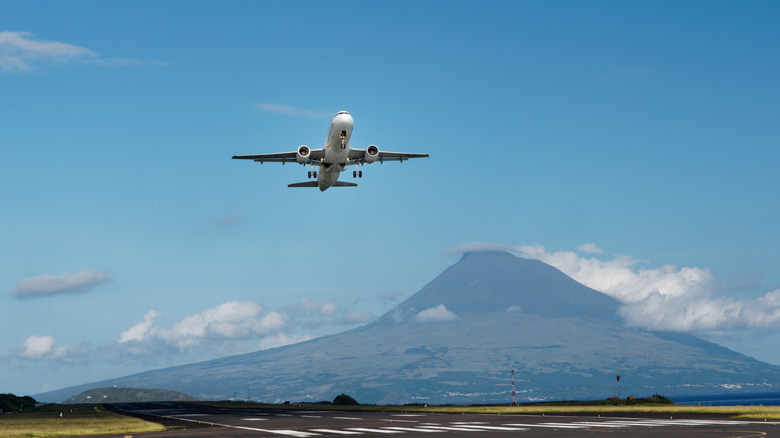An Alaskan Volcano Is On The Brink, And The Ash Could Be A Nightmare For Airplanes
Planes traveling from North America to Eastern Asia using the famed Great Circle route above the Alaskan skies could be affected by an impending volcanic eruption. A recent alert put out by the Alaska Volcano Observatory indicates that Mount Spurr — an 11,070 foot (3,370 meter) volcanic peak located 75 miles west of Anchorage — is showing signs of "unrest" that could lead to an eventual volcanic eruption.
Although Mount Spurr has been showing increased volcanic activity for the past 10 months, there has been a dramatic increase in the frequency of earthquakes around the volcano over the past few weeks, leading to the current elevation of Mount Spurr's volcano alert level.
Between December 1, 2024, and February 11, 2025, the observatory recorded heightened seismic activity beneath the mountain. The strongest tremors were observed underneath Spurr's summit around December 28, 2024, and January 3, 2025. By January 27, 2025, the location of the earthquakes moved to an area called the Crater Peak, which was also the site of the last eruption over 30 years ago — in 1992.
Spurr is currently at ADVISORY/WATCH due to earthquakes, ground deformation, & melting of ice in the summit crater of Mount Spurr. AVO is closely monitoring the volcano for changes that could indicate a more imminent eruption.(3/3)#Alaska #Volcano @USGSVolcanoes @UAFGI @akdggs
— Alaska AVO (@alaska_avo) February 18, 2025
Besides an increase in the number of earthquakes, the Alaska Volcano Observatory has also noticed phenomena like the melting of ice and deformation of the ground, which became additional reasons for the current heightened advisory level.
What makes the eruption of Mount Spurr particularly concerning for the airline industry is the fact that it has been known to emit copious amounts of volcanic ash into the atmosphere during previously recorded eruptions. Unlike lava-spewing volcanoes that most laypersons associate volcanoes with, the ash-spewing Mount Spurr poses a greater risk to the aviation industry because of the issues volcanic ash brings with it.
How does volcanic ash affect flights?
The vast majority of planes in the air today are powered by turbofan jet engines which create incredible amounts of thrust by sucking in air, compressing it using an array of fan blades, burning the fuel, and releasing this compressed air via the back. If an aircraft ends up traveling through a giant plume of volcanic ash, the particles inside the ash are sucked into the jet engine, leading to several issues.
To begin with, the high temperatures inside the jet engine cause the glass particles in volcanic ash to melt and stick to the insides of the engine. Besides affecting the efficiency of the engine, ingesting a large quantity of volcanic ash may even lead to partial or complete engine failure. Even if an engine failure doesn't happen, the ingestion of ash will almost certainly cause severe damage that will result in an expensive repair bill to the airline company.
Now that we have established that jet engines are particularly vulnerable to volcanic ash, let's move to another part of modern-day planes at increased risk of damage. The part in question here is the all-important cockpit windscreen. Volcanic ash consists of various hard, abrasive particles that effectively lead to the aircraft's fuselage being bombarded by tiny particles at high speeds. It is not uncommon for these particles to scratch the glass windows of the plane — including the front windshield of the plane — and turn them opaque. While this is a genuine safety concern, the advent of modern-day Instrument Landing Systems (ILS) more or less mitigates this issue by ensuring that pilots can safely land planes even if they do not have a visual approach to the nearest airport.
Has volcanic ash ever resulted in a crash?
Thanks to rapid advancements in volcanic eruption prediction technology and weather reconnaissance, modern aircraft are highly unlikely to encounter volcanic ash clouds. Advanced equipment now enables scientists to predict not only when a volcanic eruption may occur but also how extensive and severe the resulting ash cloud will be. This allows aviation authorities to adjust flight paths well in advance.
There are no recorded instances of modern aircraft crashing due to volcanic ash ingestion. However, past incidents serve as stark reminders of the dangers posed by volcanic plumes. One of the most notable cases occurred in 1982 when a British Airways Boeing 747 flew into an ash cloud from Mount Galunggung while cruising at 37,000 feet over Indonesia. The aircraft's engines ingested the ash, causing all four to fail. The crew attempted multiple restarts but were unsuccessful until they descended to 25,000 feet, where they managed to restart two engines — one of which had to be shut down again shortly after. Despite the harrowing ordeal, the pilots successfully executed an emergency landing, and all passengers and crew members emerged unharmed.
A similar incident took place in 1989 when a KLM Boeing 747-400, descending into Anchorage, Alaska, encountered an ash plume from Mount Redoubt at 24,000 feet. The ash caused all four engines to shut down, forcing the aircraft to glide down to 14,000 feet before the pilots managed to restart the engines. Although the plane landed safely, the ingestion of volcanic ash damaged the engines so severely that they had to be completely replaced.
These incidents underscore the significant improvements in aviation safety and volcanic monitoring over the years. Today, with enhanced predictive models and flight management, the risk of commercial aircraft encountering volcanic ash has been drastically minimized.


